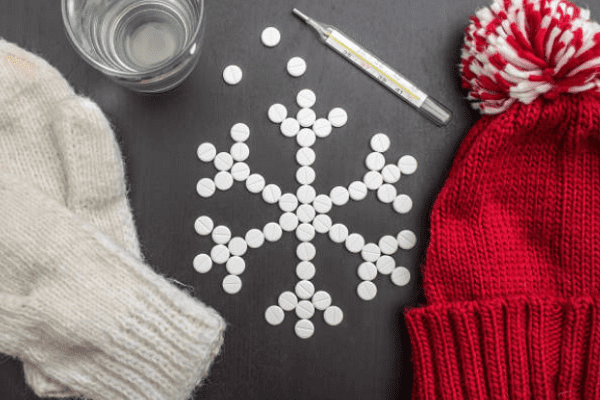Rest turned into disease >>>> What to put in your winter first aid kit
What to put in your winter first aid kit.

Winter vacations are just as great as vacations in warm seasons, but it can be overshadowed by many troubles if you do not stock up on preventive measures and first aid, going to winter resorts or simply snow trips. What to put in a winter first-aid kit to be in all weapons in frost, winter sun (no less dangerous than summer sun), with a winter cold or just a cold allergy .
The first organ that suffers from cold weather is the skin. At low temperatures, the skin needs protection, especially in those areas that are difficult to cover from the frosty wind. Frosty air tends to dry out the skin, drawing in moisture and thinning the surface layer of the skin. The result will be excessive wrinkling and cracking of the skin, which can be prevented by putting several types of cream in your winter medicine cabinet and using them regularly in a specific order. Two hours before going out into the cold, a regular water-based (moisturizing) cream is applied to the skin. It must have time to soak deeper before it comes out into the frosty air. 15-30 minutes before going out into the cold, oil creams are applied, which are designed to protect the skin from low temperatures. These oil creams should be thick, to stay in the outer layers of the skin for a long time, absorbing gradually. Such greasy oil creams form a greasy film on the surface of the skin and protect it from the cold drying air, the scalding cold wind and frost. The best oil-based winter creams are those based on avocado oil, primrose oil, and almond oil.
The role of a fatty oil heavy cream can be played by an ointment with Dexpanthenol. This product is suitable for all skin types and even for protecting baby's skin from frost while walking. Such an ointment, in addition to the obvious protective barrier, will become a remedy for frostbite, since it relieves inflammation of the skin well and stimulates the regeneration of damaged skin areas. This is another tool needed for a winter first aid kit.
Despite the fact that the winter sun is considered moderate and not suitable for sunburn, no one canceled the harmful ultraviolet effect during winter periods, especially in mountainous areas, where, despite the snow cover, the sun's rays are very active.
In addition to protective glasses from ultraviolet radiation, you must also put a protective cream against ultraviolet radiation in the winter first-aid kit, otherwise the open skin of the face will be provided with a rough tan and all the troubles associated with an ultraviolet burn of delicate skin. For winter walks under the bright rays of the sun, choose a cream with a protection factor not less than 20. In the winter first-aid kit, you also need to put lipstick (protective) with a protective ultraviolet filter.
Another factor of the body's protection in winter on vacation is immunostimulants. In the winter first-aid kit, it is necessary to find a place for recombinant interferon and herbal tonic tinctures (for example, echinacea purpurea). Or take on the road for winter holidays prepared dry mixtures of herbal immunostimulants, which you will brew as tea for the prevention of colds in winter.
Another pharmacy assistant on vacation in winter is vitamin complexes. You should always have a monthly supply of vitamin and mineral complexes in a winter first-aid kit that are useful in the winter season - these are vitamin C, vitamin A, vitamin E, B vitamins, vitamin D, Calcium, Phosphorus, Magnesium and Zinc. All these vitamins and minerals have a habit of maintaining the structure of the skin, bones, teeth, hair precisely at the time when there are not enough natural sources for nutrients in the diet. Namely, winter food is distinguished by high calorie content, but poor fortification of food.
The obligatory companions of immunostimulants in the winter medicine cabinet are anti-inflammatory drugs that relieve swelling of the mucous membranes - these are nose drops, throat sprays and ointments for the treatment of inflammation and edema in trauma. Winter rest, to a greater extent than summer, is associated with trauma, which is facilitated by ice and winter entertainment - downhill skiing, skiing or ice skating. Even an ordinary fun fall or floundering in the snow can result in an injury that will require you to spend the rest of your rest, and topical anti-inflammatory drugs quickly "work to heal" and will allow you to finish your vacation with dignity even in the event of an unsuccessful winter adventure.
Means for burns with a cooling and anti-inflammatory effect and also need to be put in a winter first-aid kit, since, contrary to the opinion that burns are injuries of the warm season, you can easily get a significant skin burn, if you come from a cold street and warming your hands by the by the fireplace or on heating devices. Such incidents often happen due to the fact that the frozen skin does not feel the degree of heating well, and you can imperceptibly go from mild frostbite to a full burn.
Adhesive plasters with a bactericidal effect, adhesive plaster with pepper, elastic bandages with fixators will always come in handy in winter, since it is winter walks that provoke the most desperate ways of entertainment, and of course, the most painful consequences.
The winter first-aid kit is collected in the fall, thinking in advance the possibilities of recreation and a set of medicines corresponding to the planned winter adventures.

Read

Read



























